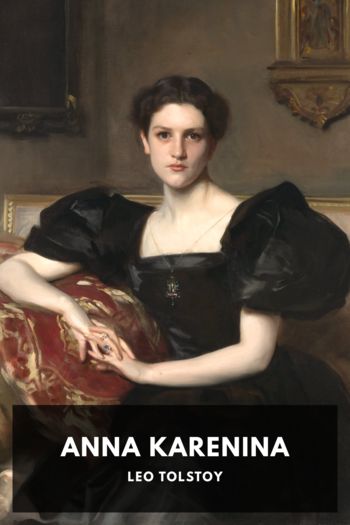What Is Art? Leo Tolstoy (good books to read for 12 year olds TXT) 📖

- Author: Leo Tolstoy
Book online «What Is Art? Leo Tolstoy (good books to read for 12 year olds TXT) 📖». Author Leo Tolstoy
Professionalism is the first condition of the diffusion of false, counterfeit art.
The second condition is the growth, in recent times, of artistic criticism, i.e. the valuation of art not by everybody, and, above all, not by plain men, but by erudite, that is, by perverted and at the same time self-confident individuals.
A friend of mine, speaking of the relation of critics to artists, half-jokingly defined it thus: “Critics are the stupid who discuss the wise.” However partial, inexact, and rude this definition may be, it is yet partly true, and is incomparably juster than the definition which considers critics to be men who can explain works of art.
“Critics explain!” What do they explain?
The artist, if a real artist, has by his work transmitted to others the feeling he experienced. What is there, then, to explain?
If a work be good as art, then the feeling expressed by the artist—be it moral or immoral—transmits itself to other people. If transmitted to others, then they feel it, and all interpretations are superfluous. If the work does not infect people, no explanation can make it contagious. An artist’s work cannot be interpreted. Had it been possible to explain in words what he wished to convey, the artist would have expressed himself in words. He expressed it by his art, only because the feeling he experienced could not be otherwise transmitted. The interpretation of works of art by words only indicates that the interpreter is himself incapable of feeling the infection of art. And this is actually the case, for, however strange it may seem to say so, critics have always been people less susceptible than other men to the contagion of art. For the most part they are able writers, educated and clever, but with their capacity of being infected by art quite perverted or atrophied. And therefore their writings have always largely contributed, and still contribute, to the perversion of the taste of that public which reads them and trusts them.
Artistic criticism did not exist—could not and cannot exist—in societies where art is undivided, and where, consequently, it is appraised by the religious understanding-of-life common to the whole people. Art criticism grew, and could grow, only on the art of the upper classes, who did not acknowledge the religious perception of their time.
Universal art has a definite and indubitable internal criterion—religious perception; upper-class art lacks this, and therefore the appreciators of that art are obliged to cling to some external criterion. And they find it in “the judgments of the finest-nurtured,” as an English aesthetician has phrased it, that is, in the authority of the people who are considered educated, nor in this alone, but also in a tradition of such authorities. This tradition is extremely misleading, both because the opinions of “the finest-nurtured” are often mistaken, and also because judgments which were valid once cease to be so with the lapse of time. But the critics, having no basis for their judgments, never cease to repeat their traditions. The classical tragedians were once considered good, and therefore criticism considers them to be so still. Dante was esteemed a great poet, Raphael a great painter, Bach a great musician—and the critics, lacking a standard by which to separate good art from bad, not only consider these artists great, but regard all their productions as admirable and worthy of imitation. Nothing has contributed, and still contributes, so much to the perversion of art as these authorities set up by criticism. A man produces a work of art, like every true artist expressing in his own peculiar manner a feeling he has experienced. Most people are infected by the artist’s feeling; and his work becomes known. Then criticism, discussing the artist, says that the work is not bad, but all the same the artist is not a Dante, nor a Shakespeare, nor a Goethe, nor a Raphael, nor what Beethoven was in his last period. And the young artist sets to work to copy those who are held up for his imitation, and he produces not only feeble works, but false works, counterfeits of art.
Thus, for instance, our Pushkin writes his short poems, Evgeniy Onegin, The Gipsies, and his stories—works all varying in quality, but all true art. But then, under the influence of false criticism extolling Shakespeare, he writes Boris Godunoff, a cold, brain-spun work, and this production is lauded by the critics, set up as a model, and imitations of it appear: Minin by Ostrovsky, and Tsar Boris by Alexée Tolstoy, and such imitations of imitations as crowd all literatures with insignificant productions. The chief harm done by the critics is this, that themselves lacking the capacity to be infected by art (and that is the characteristic of all critics; for did they not lack this they could not attempt the impossible—the interpretation of works of art), they pay most attention to, and eulogise, brain-spun, invented works, and set these up as models worthy of imitation. That is the reason they so confidently extol, in literature, the Greek tragedians, Dante, Tasso, Milton, Shakespeare, Goethe (almost all he wrote), and, among recent writers, Zola and Ibsen; in music, Beethoven’s last period, and Wagner. To justify their praise of these brain-spun, invented works, they devise entire theories (of which the famous theory of beauty is one); and not only dull but also talented people compose works in strict deference to these theories; and often even real artists, doing violence to their genius, submit to them.
Every false work extolled by the critics serves as a door through which the hypocrites of art at





Comments (0)